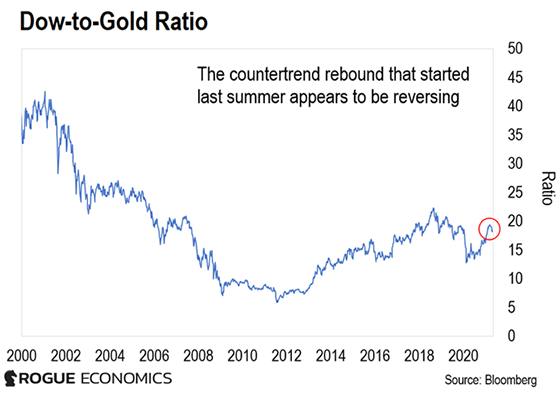LONDON, ENGLAND – We have bet our entire life savings – more than a million dollars – on a simple chart pattern, the Dow-to-Gold ratio.
And right now, something very interesting is developing in the chart pattern.
Before I show you what’s happening in the chart today, though, I’ll quickly reexplain the significance of the Dow-to-Gold ratio to me.
More below. But first…
Homeschooling Family
Greetings from London…
My family and I are a homeschooling family, specializing in experiential-based learning activities.
With all its history and museums, London is a feast for a homeschool family like us.
Our eldest son, Dusty (13), is fascinated by the Second World War, for example. Here we are at the Imperial War Museum last week.
There aren’t many tourists in London at the moment and the museum was almost empty. Our next museum visit: the Tower of London.

|
At the Imperial War Museum with Dusty (13), Penny (8), and Miles (11)
London also offers us opportunities to introduce the kids to team sports, something they’ve never experienced before.
We’ve joined a rowing club and a cricket club. In the winter, we’ll join a rugby club. Here’s Dusty preparing to go into bat last week…

|
Dusty preparing to go into bat in cricket
Only Two Things to Do With Excess Capital
Back to the Dow-to-Gold ratio…
As I see it, there are only two things one can do with excess capital (other than spend it): You can save it or you can invest it.
Saving capital means putting your capital under the mattress, burying it in the backyard, or locking it away in an iron safe.
There it stays, isolated from all risk, including currency inflation (more on this below), until you need it. You have removed it from the economy. It isn’t stranded, but it is isolated.
Investing means letting someone else take control of your capital. In return for giving up control of your capital, you receive a return. Financing a business or making a loan to a borrower are examples of investing.
Before we get any further, let me clarify a couple of things…
First, my thinking is black-and-white about the difference between saving and investing. Most people would consider money deposited in a bank account to be savings, for example. I don’t.
That capital is not fenced off. While it appears to sit in your account, the bank uses it, often in very risky ways, to generate profits. So the way I see it, bank deposits are investments.
Second, by this strict definition of savings… gold, silver, and any other ultra-hard assets are the only forms of savings. Dollars and other fiat currencies are not an appropriate form of savings, in my mind, because they do not protect you against inflation.
So how do we know when it’s a good time to save, and when it’s a good time to invest? That’s where the Dow-to-Gold ratio comes in…
Our Dow-to-Gold Strategy in a Nutshell
The popularity of saving and investing goes through cycles in the marketplace. It’s to do with human psychology.
Individual decision-making in crowded marketplaces results in self-reinforcing cycles. These cycles are called virtuous circles when they’re making people wealthier… or doom loops when they’re making people poorer.
If you look back at 120 years of American financial history, or 200 years of English financial history before that, you’ll see clear evidence of these cycles.
Sometimes, the marketplace favors saving. Sometimes, it favors investing. And once one of these trends gets in motion, it tends to stay in motion – sometimes for decades…
This brings us back to the Dow-to-Gold ratio.
The Dow-to-Gold ratio is the way I monitor the tug-of-war between saving and investing in the marketplace. The Dow Jones Index represents investing. Gold represents saving.
Simply, when the Dow-to-Gold ratio is high, “investing” has been attracting more capital than saving… and the price of investment vehicles will have risen. (This shows up in the markets as a general rise in the valuation of stocks.)
And when the Dow-to-Gold ratio is low, “saving” has been attracting more capital than investing… and the price of gold and other hard assets will have risen while the valuation of stocks will have fallen.
As contrarian investors looking to grow wealth over the long term, we always want to do the opposite of what’s fashionable in the marketplace.
In other words, we want to buy low and sell high and get the best yields on our capital. So Kate and I use the Dow-to-Gold ratio to drive a very simple capital allocation strategy:
When the marketplace is excited about investing, and the Dow-to-Gold ratio is high, we go to savings (in gold).
And when the marketplace is excited about saving, and the Dow-to-Gold ratio is low, we go to investments (in high quality, dividend-paying equities – what I call “corporate aristocrats”).
That’s our strategy, in a nutshell.
Timing the Next Turning Point
The last turning point in the Dow-to-Gold ratio was a high, in 2000, when investing was extremely popular and saving was extremely unpopular.
The next turning point in the Dow-to-Gold ratio will be a low. Investing will be extremely unpopular and saving will be extremely popular. I assume we’ll see this low sometime in the next 10 years.
We’re currently between these two extremes, but the primary trend in the ratio is down.
The Dow-to-Gold ratio is in process of falling from a peak of over 41 (set in 1999) to a low below 5, probably by the end of this decade. I call this the long walk down the mountain.
This is why Kate and I have put almost all our net worth into gold… And there we’ll stay until we get a great opportunity to buy great companies like Coca-Cola, Johnson & Johnson, and McDonald’s at bargain prices.
That, we hope, will be sometime in the next 10 years. Which brings me to this chart of the Dow-to-Gold ratio…

|
As longtime readers know, the Dow-to-Gold ratio has one of the clearest cycles in all of finance and economics. (You can see the ratio going back 120 years here.)
Still, as with any price series, there are periodic countertrend rebounds that move in the opposite direction to the primary trend.
We’ve seen one of these countertrend rebounds over the last eight months. It’s taken the Dow-to-Gold ratio from 13.4 to 19.4.
But recently, that counter trend rebound has reversed… And it appears that a new downtrend is forming.
If my thesis about all this is correct, I think it’s quite likely the primary trend is reestablishing itself… and the next big leg down in the Dow-to-Gold ratio is now upon us…
In which case, gold will consistently outperform the Dow for the next few years…
We’ll see.
– Tom Dyson
P.S. Since I expect gold to keep outperforming the Dow… and our primary trend is getting reestablished… it’s the perfect time to build (or add to) a position in gold and other hard assets. If you’d like help with how to do just that… I outline an entire model portfolio and my top gold picks in my paid service, Tom’s Portfolio. Watch this to learn more.
Like what you’re reading? Send your thoughts to [email protected].
FROM THE MAILBAG
An invitation to meet the Dyson family… and readers are thrilled Tom has decided to purchase his late mother’s London home…
Reader comment: Welcome to London during partial lockdown. My family and I moved back here from California during the 2020 lockdown. Chiswick is a lovely part of the world and we live about 20 minutes away. We would love to take you all out for a meal once you are free from quarantine. Our boys are 13 and 10 years old and have lived with us in London, Belgium, Kenya, India, and the U.S. I’m sure they would enjoy meeting your kids.
Reader comment: I think it’s a great idea to keep your mom’s home. It’s a part of your life, it has a great grounding (in spiritual sense) value, it’s beautiful and cozy, and I’m sure you can afford it. The only downside (for me) is that it is in London, where you never know what kind of draconian lockdown they can come up with. All the best!
Reader comment: What a very moving picture of you and your brother at the water. It brought tears. Your mom looks down from heaven upon you all. Rest assured. Your home will be a place for your brother also to continue with.
One can own things and not be attached to them, even with all of the memories. It’s where your consciousness is that counts. The best of life to you all.
Reader comment: I’m glad to hear you are considering putting down roots and mostly in your mum’s house. There is a feeling deep in our heart, I believe, that longs for roots and family connection. What better place than mum’s house?
It sounds like the kids enjoyed having some roots and friends in Driggs, think. And you can always sell… but once it’s gone, it’s gone. Your children look happy, too!! I would keep that beautiful house and all the love and memories. Money can’t buy that ever! Best of luck with your decision and blessings to you all.
Reader comment: As much as I have been enjoying your adventures around the world as a young family, a warm feeling came over me that I can’t explain, knowing it’s quite possible you will remain in your mother’s home.
Tom’s note: Thank you all for your kind words and encouragement. We read every message you send us. Please keep writing us at [email protected], and I’ll do my best to respond in a future Friday mailbag edition.